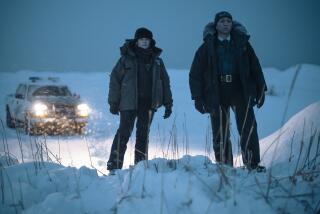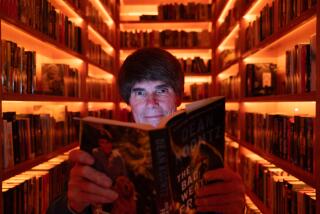Book review: ‘What the Night Knows’ by Dean Koontz
- Share via
Midway through Dean Koontz’s new novel, “What the Night Knows,” there’s a scene that epitomizes everything the book could have been. Eight-year-old Minnie and her 11-year-old sister detect a recurrent shadow in the mirror mounted on their closet door. When they take down the mirror to examine it, Minnie grabs a handful of grapes and drops them one by one on the mirror’s surface. And one by one they plunge straight through, leaving behind only a slow-expanding set of spectral rings on the mirror’s glass. It’s a quiet, chilling moment.
Alas, there aren’t enough such moments. Instead of the ghost story the scene promises, we get a three-way collision of serial-killer high jinks, consumerism and overwrought prose. The story’s serial killer angle comes courtesy of John Calvino, a homicide detective who becomes convinced that a recent spate of murders echoes the 20-year-old crime spree of Alton Blackwood, which culminated in the slaughter of Calvino’s entire family. Calvino, a mere teenager at the time, had returned home in time to kill Blackwood at his postmortem fun. Now, plagued by survivor guilt, Calvino can’t help wondering if Blackwood has returned from the grave, using hosts to re-enact his murder spree and finish his business with Calvino.
The action that follows, however, is the antithesis of the quiet unease inspired by those grapes. Instead, we get Blackwood’s search for suitable hosts — not a difficult task, it turns out, because Blackwood tries only six or seven people before he locates two more serial killers (imagine the odds!). Such implausibilities pile up quickly. We get a corrupt cop murdering his partner. We get people plunging from the top story of a hospital. We get a resurrected corpse, a ghost dog and a description of Blackwood’s murder rituals, which include disks of dried feces and nickels painted black. We get pistols, shotguns, a butcher knife and a cleaver.
That cleaver is important because it goes to the heart (pun intended) of the novel’s central problem: the impossibly perfect Calvino family who live in perfect splendor among their many perfect possessions in their impossibly perfect mansion. Calvino’s wife, Nicky, is profoundly beautiful and a well-known painter; the children — all homeschooled — are imaginative, disciplined and precocious enough to discuss the Italian Renaissance over dinner. Even their former dog (the one who returns from the dead to fight for his family) is the “best, sweetest, noblest dog in the world.”
The personal perfection extends to the Calvinos’ home, a magnificent white-brick Georgian with three stories — “four, if you counted the subterranean garage.” The master suite features a “white marble fireplace [with] ebony inlays,” a sitting room, and a black-granite bar stocked with Cakebread wines, which run to $50 a bottle on the low end. And the cleaver? Even as it’s being snatched up as a murder weapon, the narrative pauses to assure us that the Calvinos are “good customers of Williams Sonoma, and they only buy the best.”
Though Koontz is an effective stylist, the writing here too often slips. Sometimes the images are so ornate that it’s hard to take them seriously, or else the writer slips into abstraction, taking the express route to characterization, describing a minor character as a “good man who had become a fan of the Food Network” and the character’s daughter in still more abstract terms: “Her beauty was enchanting … because it was a beauty equally of body, mind, and soul.”
In the end, such abstractions undermine the book as a whole and momentum flags, leaving the reader thirsting for something more — a bottle of Cakebread Cabernet wouldn’t hurt.
Bailey is the author of the novels “House of Bones” and “The Fallen,” and a collection of short stories, “The Resurrection Man’s Legacy and Other Stories.
More to Read
Sign up for our Book Club newsletter
Get the latest news, events and more from the Los Angeles Times Book Club, and help us get L.A. reading and talking.
You may occasionally receive promotional content from the Los Angeles Times.






